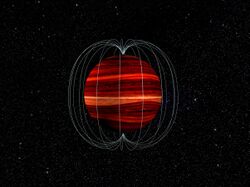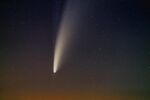Astronomy:2MASS J10475385+2124234
Coordinates: ![]() 10h 47m 53.85s, +21° 24′ 29.8″
10h 47m 53.85s, +21° 24′ 29.8″
| Observation data Equinox J2000.0]] (ICRS) | |
|---|---|
| Constellation | Leo |
| Right ascension | 10h 47m 53.85456s[1] |
| Declination | 21° 24′ 23.4684″[1] |
| Characteristics | |
| Spectral type | T6.5 |
| Apparent magnitude (J) | 15.819 ± 0.059[1] |
| Apparent magnitude (H) | 15.797 ± 0.120[1] |
| Apparent magnitude (K) | 16.20 ± 0.03[1] |
| Astrometry | |
| Proper motion (μ) | RA: -1714[1] mas/yr Dec.: -489[1] mas/yr |
| Parallax (π) | 94.73 ± 3.81 mas |
| Distance | 34 ± 1 ly (10.6 ± 0.4 pc) |
| Details | |
| Mass | 41.61 ± 26.03[2] MJup |
| Radius | 0.94 ± 0.16[2] RJup |
| Luminosity | 0.000004365[3] L☉ |
| Surface gravity (log g) | 4.96 ± 0.49[2] cgs |
| Temperature | 880 ± 76[4] K |
| Rotation | 1.77 ± 0.04 h[4] |
| Age | 0.5–10[2] Gyr |
| Other designations | |
| Database references | |
| SIMBAD | data |
2MASS J10475385+2124234 (abbreviated to 2MASS J1047+21) is a brown dwarf of spectral class T6.5, in the constellation Leo about 34 light-years from Earth, hence in galactic topographical and interstellar medium study terms being in the Local Bubble and very nearby in the Orion Arm. It is the first brown dwarf to have an inferred range of its typical wind speeds computed.
Discovery
2MASS J1047+21 was discovered in 1999 along with eight other brown dwarf candidates by Adam J. Burgasser et al. from Two Micron All-Sky Survey (2MASS), conducted from 1997 to 2001. Follow-up observations with the Keck I 10-meter telescope's Near Infrared Camera (NIRC) were conducted on 27 May 1999 and identified methane in 2MASS J1047+21's near-infrared spectrum, classifying it as a T-type brown dwarf.[5]
Methodology
The wind speed is directly inferred from minute, regular cycles in its visible (which matches its ultra-violet) appearance compared to the same at radio wave spectra.[6][7][8][9] The radio emissions are coming from electrons interacting with the magnetic field, which is rooted deep in the interior.[8] The visible and infrared (IR) data, on the other hand, reveal what's happening in the gas giant's cloud tops.[8]
Distance
2MASS J1047+21 is about 34 light-years (10 pc) from Earth.[4]
Characteristics
2MASS J1047+21 is a T-type brown dwarf.[5]
Wind speeds
Wind speeds on 2MASS J1047+21 were measured to be 650 ± 310 metres per second (1,450 ± 690 mph) by the Spitzer Space Telescope.[4][10][11]
See also
References
- ↑ 1.00 1.01 1.02 1.03 1.04 1.05 1.06 1.07 1.08 1.09 1.10 "2MASSW J1047539+212423 -- Brown Dwarf (M<0.08solMass)". SIMBAD. Centre de données astronomiques de Strasbourg. http://simbad.u-strasbg.fr/simbad/sim-id?Ident=2MASSW+J1047539+212423. Retrieved 23 May 2020.
- ↑ 2.0 2.1 2.2 2.3 Filippazzo, Joseph C.; Rice, Emily L.; Faherty, Jacqueline; Cruz, Kelle L.; Van Gordon, Mollie M.; Looper, Dagny L. (September 2015). "Fundamental Parameters and Spectral Energy Distributions of Young and Field Age Objects with Masses Spanning the Stellar to Planetary Regime". The Astrophysical Journal 810 (2): 46. doi:10.1088/0004-637X/810/2/158. 158. Bibcode: 2015ApJ...810..158F.
- ↑ Williams, Peter K. G.; Berger, Edo; Zauderer, B. Ashley (April 2013). "Quasi-quiescent Radio Emission from the First Radio-emitting T Dwarf". The Astrophysical Journal Letters 767 (2): 6. doi:10.1088/2041-8205/767/2/L30. L30. Bibcode: 2013ApJ...767L..30W.
- ↑ 4.0 4.1 4.2 4.3 Allers, Katelyn N.; Vos, Johanna M.; Biller, Beth A.; Williams, Peter K. G. (10 April 2020). "A measurement of the wind speed on a brown dwarf". Science 368 (6487): 169–172. doi:10.1126/science.aaz2856. PMID 32273464. Bibcode: 2020Sci...368..169A. https://www.pure.ed.ac.uk/ws/files/154026451/Windspeed_accepted.pdf.
- ↑ 5.0 5.1 Burgasser, Adam J.Expression error: Unrecognized word "etal". (September 1999). "Discovery of Four Field Methane (T-Type) Dwarfs with the Two Micron All-Sky Survey". The Astrophysical Journal 522 (1): L65–L68. doi:10.1086/312221. Bibcode: 1999ApJ...522L..65B.
- ↑ Finley, Dave (9 April 2020). "Astronomers Measure Wind Speed on a Brown Dwarf". National Radio Astronomy Observatory. https://public.nrao.edu/news/brown-dwarf-wind-speed/. Retrieved 23 May 2020.
- ↑ Cofield, Calla (9 April 2020). "In a First, NASA Measures Wind Speed on a Brown Dwarf". Jet Propulsion Laboratory (NASA). https://www.nasa.gov/feature/jpl/in-a-first-nasa-measures-wind-speed-on-a-brown-dwarf. Retrieved 23 May 2020.
- ↑ 8.0 8.1 8.2 Wall, Mike (9 April 2020). "How the brown dwarf blows: Wind speed of a 'failed star' measured for 1st time". https://www.space.com/brown-dwarf-wind-speed-measured-first-time.html. Retrieved 23 May 2020.
- ↑ Anderson, Paul Scott (15 April 2020). "First-ever measure of brown dwarf wind speed". EarthSky. https://www.space.com/brown-dwarf-wind-speed-measured-first-time.html. Retrieved 23 May 2020.
- ↑ Allers, Katelyn; Vos, Johanna; Biller, Beth; Williams, Peter; Berger, Edo (August 2016). "Wind speeds on extrasolar worlds". Spitzer Proposal (Infrared Science Archive): 13031. Bibcode: 2016sptz.prop13031A. https://sha.ipac.caltech.edu/applications/Spitzer/SHA/#id=SearchByProgram&RequestClass=ServerRequest&DoSearch=true&SearchByProgram.field.program=13031.
- ↑ Allers, Katelyn; Vos, Johanna; Biller, Beth; Williams, Peter (October 2017). "Measuring the wind speed on a radio-emitting brown dwarf". Spitzer Proposal (Infrared Science Archive): 13231. Bibcode: 2017sptz.prop13231A. https://sha.ipac.caltech.edu/applications/Spitzer/SHA/#id=SearchByProgram&RequestClass=ServerRequest&DoSearch=true&SearchByProgram.field.program=13231.
External links
Wikidata has the property:
|
- In a First, NASA Measures Wind Speed on a Brown Dwarf, Calla Cofield, Jet Propulsion Laboratory, 9 Apr 2020
- Astronomers Measure Wind Speed on a Brown Dwarf, Dave Finley, National Radio Astronomy Observatory, 9 Apr 2020
- Planet 2MASS J10475385+2124234, The Extrasolar Planets Encyclopaedia
- Astronomers measure wind speed on a brown dwarf, Phys.org, 9 Apr 2020
- Astronomers Measure the Wind Speed on a Brown Dwarf for the First Time. Spoiler: Insanely Fast, Evan Gough, Universe Today, 15 Apr 2020
 |






